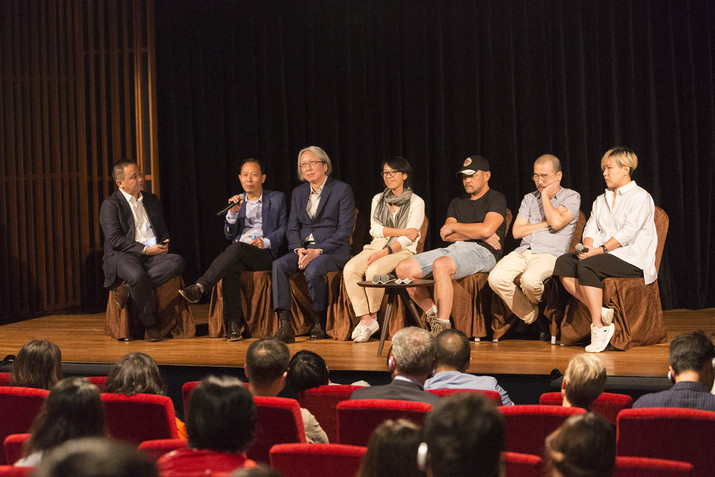
R
E
V N
E
X
T
Late to the game but still promising an examination of urbanization’s trajectory in the Pearl River Delta, the latest M+ Matters symposium was introduced by the museum’s deputy director and chief curator, Doryun Chong, at the Asia Society Hong Kong Center. Working in conjunction with, and actually catalyzed by, the “Canton Express” exhibition that was partially re-installed at the M+ Pavilion—the museum’s permanent presentation space at Hong Kong’s West Kowloon Cultural District—Chong described the premise of the discussion by introducing the show itself.
As reviewed by ArtAsiaPacific, “Canton Express” was the second iteration of a landmark project “Zone of Urgency (Z.O.U)” first curated by Hou Hanru at the 50th Venice Biennale in 2003. The seminal works that were exhibited in Venice looked back at the explosive urbanization and expansion of the Asia-Pacific region, and was restaged to be unpacked within its own geographical and cultural context. The exhibition also celebrated the donation of the 37 works, which were created between 1979 and 2005, to the M+ Museum by the influential Chinese collector Guan Yi in 2013. All things considered, including the area’s infrastructural changes, such as the soon-to-be completed Hong Kong-Zhuhai-Macau Bridge and the high-speed Express Rail Link tying Hong Kong to Guangzhou and Shenzhen, the exhibition and symposium shifted the focus of discourse about the Pearl River Delta to the people affected by its changing landscape, and examined the region’s socioeconomic and cultural changes that are to ensue in the Pearl River Delta and Greater Bay Area of China.
The symposium’s speakers included practitioners and specialists who are rooted in the region’s art, architecture and literature scenes; they began with discussions on the changing economic and cultural models of the region, placing critical importance on examining the evolution of the zone’s curatorial strategies and art research from the late 1990s to the present. Pi Li, M+’s Sigg Collection senior curator and moderator of the symposium, was joined by keynote speakers Hou Hanru, artistic director of MAXXI in Rome and curator of “Z.O.U,” as well as writer and cultural critic Chan Koonchung.
Hou’s speech shed light on the changing urban experiences in China that came with globalization’s rise, and the subsequent unorthodox cultural ecology that manifests as alternative and self-organizing art spaces and temporary, informal, unofficial structures. Over the years, this stimulated the interest of progressive art and architecture practitioners worldwide. He posed a question: “How do we imagine a new room for freedom?” Hou spoke pointedly about the free software movement that has come with the emergence of the internet, and speculated on ways artists and institutions can occupy new spaces that are wholly autonomous under the shifting political landscape of the PRD. The second keynote speaker, Chan, who is seemingly a skeptic by nature, asked new questions about urbanization and the PRD’s infrastructure developments, and its political agendas. Key to his address was the idea of spatial justice—he advocated for “multi-dimension spaces” that will lead to a “symbiotic system” for urbanization in the cross-border region. In his eyes, the deep-rooted disharmony in the distribution of space as the region’s cultural topographies merge, presents a problem that needs to be solved—otherwise, it invites the risk of an unsustainable urban structure economically dominated by those in power or commercially invested.
In the last hour, Pi Li examined the history and future of the Greater Bay Area with keynote speakers Hou and Chan, as well as a few other guest panelists, including artist Cao Fei; founder of Liberia Borges Chen Tong; professor of Sun Yat-sen University and cultural critic Feng Yuan; and artist Sara Wong, who is also a co-founder of one of Hong Kong’s first nonprofit art spaces, Para Site. Chen and Feng went down memory lane and discussed how much the region has changed since the 1980s, developing into an international “delta” and “bay area” of southern China, equating it to North America’s San Francisco. Cao Fei recalled the visibly changing landscape of the Greater Bay Area that has phenomenally flourished over the course of her artistic career, and how it had cast her early interest in this urban hotspot as a new space for innovation.
Calling on their institutional backgrounds, Feng and Sara dissected the recent history of Guangzhou, Shenzhen, and Hong Kong’s cultural landscapes, which have faced challenges brought on by their rapid transformation from a cross-border manufacturing hub to one of finance and tech. Feng steered the conversation down a different path, noting that the Pearl River had been instrumental to the open development of Shenzhen after Deng Xiaoping designated the former fishing village as a Special Economic Zone in the ’80s. The panelists all spoke of finding a way to “co-exist” in this volatile, contemporary and radical environment.
The symposium ended on a positive note, with Chen addressing the artists and cultural institutions to “change the soil” of the cities that they call home. “Take responsibility” he said, “although dreams and imaginations might never really be achieved, what you can change is to expand your ideas and influence.”
Julee WJ Chung is ArtAsiaPacific’s assistant editor.
To read more of ArtAsiaPacific’s articles, visit our Digital Library.



